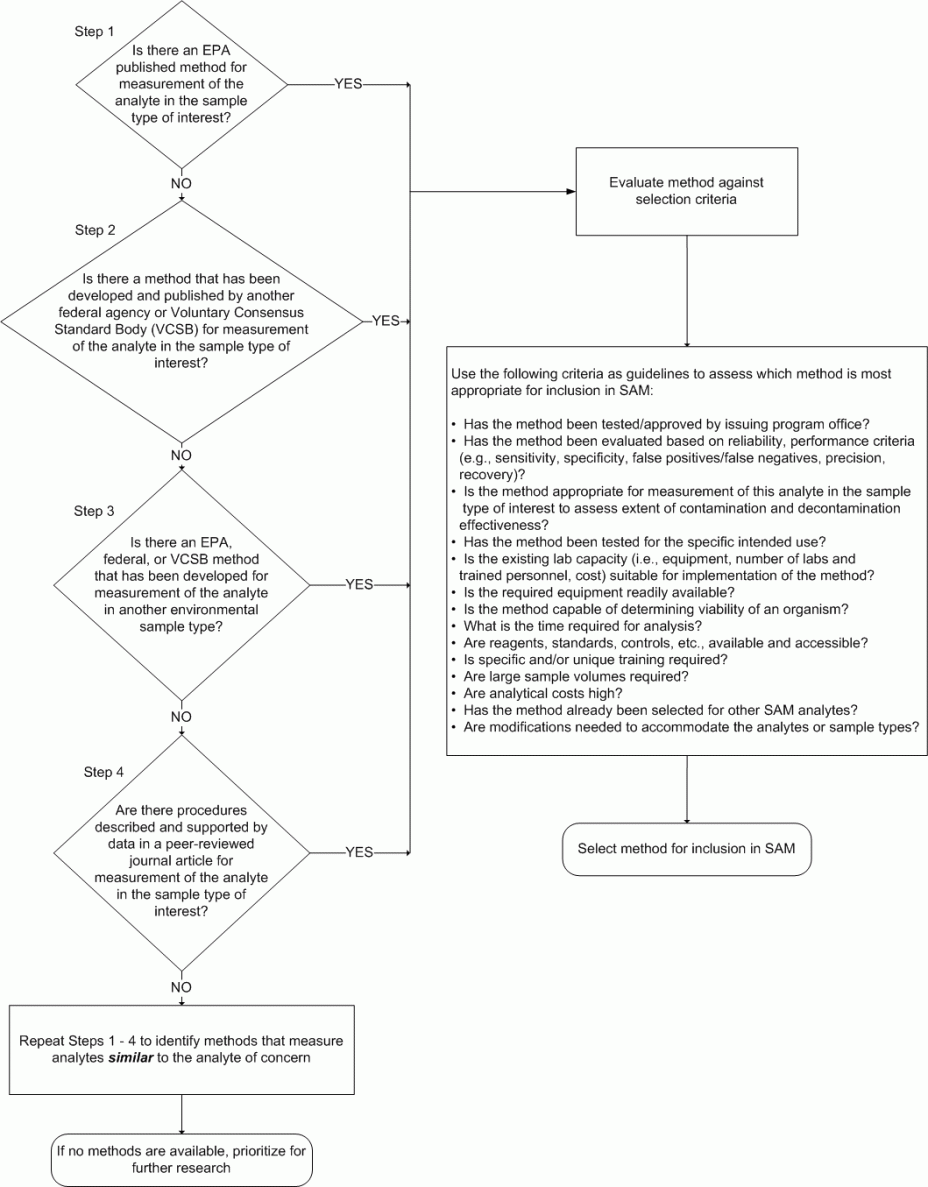SAM Background
In support of Selected Analytical Methods for Environmental Remediation and Recovery (SAM), EPA periodically assembles methods experts from within EPA, as well as other federal, state and local agencies; public utilities; national laboratories; and academia, to review and, if necessary, revise the methods listed. SAM analytes are included based on selection criteria that address the needs and priorities of EPA as well as other federal agencies (e.g., environmental persistence, half lives, availability, and toxicity). The sample types listed in SAM are specific to each technical section and have been determined by SAM technical work groups to be a concern during site remediation. SAM identifies a single method (or method group) for each analyte/sample type to ensure a consistent analytical approach across multiple laboratories when analyzing environmental and building material samples. Method selection is based on consideration of specific criteria that emphasize method performance and include existing laboratory capabilities, laboratory capacity, method applicability to multiple sample types, and method applicability to multiple SAM analytes. For some analytes, the preferred method is a clear choice; for others, competing criteria make the choice more difficult. Final method selections are based on technical recommendations from SAM work groups. For analytes where limited laboratory capacity exists, such as chemical warfare agents (CWAs), SAM work groups select methods based on their applicability to similar chemicals (e.g., nerve agents and some pesticides). In these cases, laboratory studies to evaluate the ability of the selected method to measure the target analyte(s) are either underway or needed. Figure 2-1 summarizes steps and provides the criteria used during the SAM method selection process. It is important to note that the method selection criteria included in this figure are listed in non-hierarchical order and, in some cases, only a subset of the criteria is considered.
Since 2004, EPA has brought together experts from across the agency and its sister agencies to develop this compendium of analytical methods to be used when analyzing environmental and building material samples during site characterization, remediation and clearance following contamination incidents. Participants have included representatives from EPA program offices, EPA regions, EPA laboratories, Centers for Disease Control and Prevention (CDC), Food and Drug Administration (FDA), Department of Homeland Security (DHS), Federal Bureau of Investigation (FBI), Department of Defense (DoD), Department of Agriculture (USDA), U.S. Geological Survey (USGS), numerous state agencies and universities. SAM work groups consider methodologies for chemical, radiochemical, biological and biotoxin agents of concern in the types of environmental and building material samples that would be anticipated. The primary objective of this effort is to support EPA's Environmental Response Laboratory Network (ERLN) and Water Laboratory Alliance (WLA) by identifying appropriate SAM methods that represent a balance between providing existing, documented techniques and providing consistent and valid analytical results.
SAM work groups conduct surveys of available analytical methods using existing resources, including the following:
- National Environmental Methods Index (NEMI) and NEMI for Chemical, Biological and Radiological Methods (NEMI-CBR)
- Environmental Monitoring Method Index (EMMI)
- EPA Test Methods Index
- EPA Office of Water Methods
- EPA Office of Solid Waste SW-846 Methods
- EPA Microbiological Methods
- National Institute for Occupational Safety and Health (NIOSH) Manual of Analytical Methods (NMAM)
- Occupational Safety and Health Administration (OSHA) Index of Sampling and Analytical Methods
- AOAC International
- ASTM International
- International Organization for Standardization (ISO) methods
- Standard Methods for the Examination of Water and Wastewater
- Scientific Literature
Since publication of SAM Revision 1.0 in September 2004, EPA has continued to convene technical workgroups to evaluate and, if necessary, update the analytes and methods that are listed. Details regarding changes that have been incorporated into each revision of SAM are provided in Archived SAM Documents and SAM Updates. SAM 2012 also includes a title change to better reflect SAM's focus on providing selected analytical methods for use across multiple laboratories during environmental remediation and recovery. The current revision (SAM 2012) includes the addition of vegetation as a sample type under the radiochemistry sections, the addition of method applicability tiers to methods selected for chemical contaminants (See SAM 2012 Appendix A: Selected Chemical Methods), several new methods added or replaced for currently listed chemical analytes, clarification of immunoassay methods listed for biotoxin analytes, and the addition of restructured pathogen sections to more clearly define scope and application.
In addition to updating SAM analytes and methods, SAM work groups have identified three areas for development of SAM companion documents to provide information regarding sample collection, rapid screening and preliminary analysis equipment, and sample disposal to supplement the SAM analytical methods. The information listed in these documents generally corresponds to the analytes and methods in SAM and is updated as resources allow to reflect SAM revisions. SAM companion documents are posted on the SAM website (SAM Companion Documents and Sample Collection Procedures) as they become available.
Figure 2-1. SAM Method Selection Process (Click to review figure)

